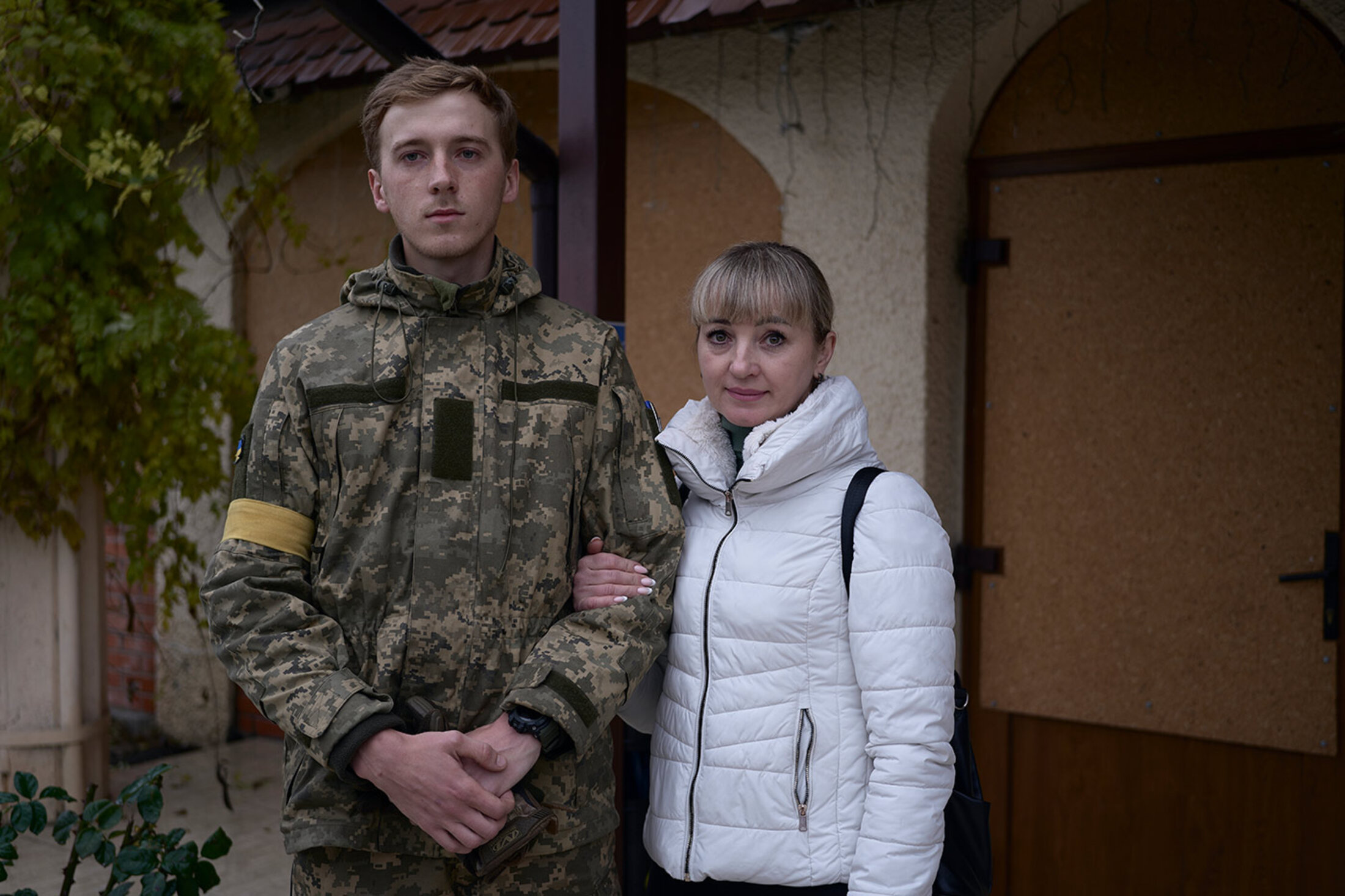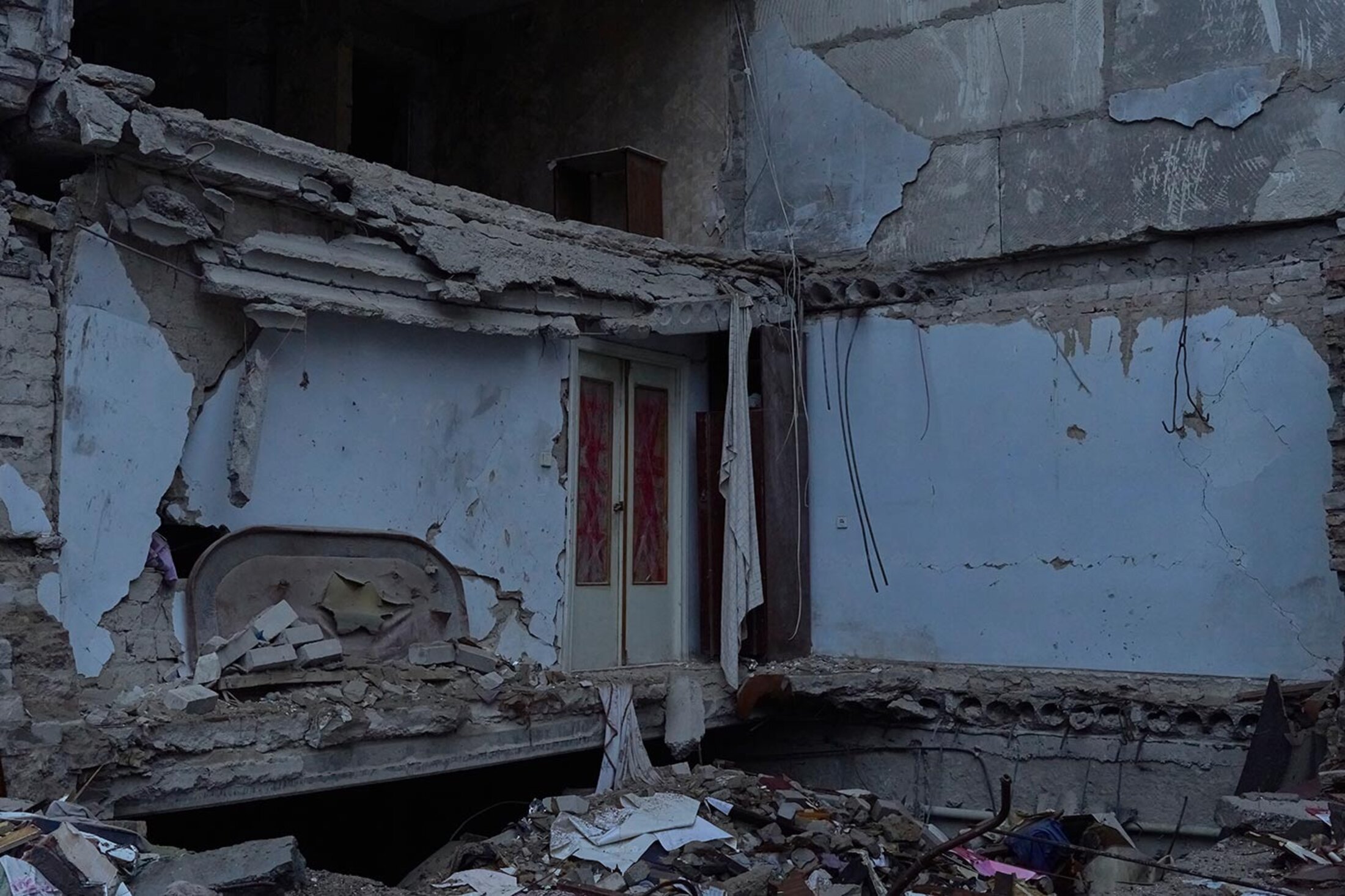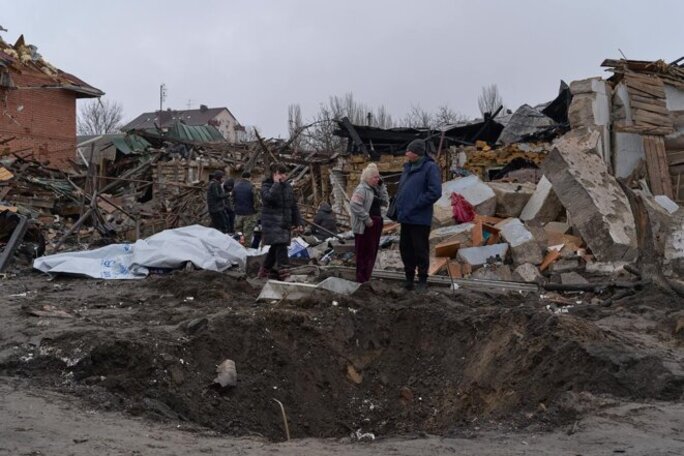Mykolaiv lies alongside the Southern Buh River about 60 kilometres, as the crow flies, north-west of Kherson, the southern Ukrainian city recaptured from Russian occupation on November 11th. It is a shipbuilding centre and transportation hub due to its access downriver to the Black Sea, and is a key city in Kyiv’s battle to gain control elsewhere in the south.
Fierce battles between Ukrainian and Russian forces raged all around Mykolaiv this summer, until the Russians latterly concentrated their efforts on the Kherson region, although Mykolaiv continued to be regularly shelled.
When Mediapart visited the city last Thursday, one local inhabitant said the bombardment of Mykolaiv through the summer months took place in systematic waves, at around 11pm, then 2am. Although the Russians retreated from the city of Kherson in mid-November, they have continued with their shelling from the eastern bank of the Dnipro River to where they escaped.
Mykolaiv had a population of close to 500,000 up until the Russian invasion of Ukraine began on February 24th this year, but since that day around 60% of the inhabitants have left. The city is surrounded by check-points, tyres are stacked around the electric distribution boards located at the feet of supply poles, and protective sandbags are piled up against local monuments. The lack of electricity supply has rendered the local public transport system inoperable, explained the local deputy mayor, Vitaly Louko.
Mains-delivered drinking water has been unavailable for months, and the saltwater that runs in a secondary network has rusted pipes. Houses, schools and factories have been destroyed by the bombardments, and turned into rubble.
When Mediapart toured Mykolaiv last week, the city’s streets seemed to be all plunged into darkness as of when light faded at around 5pm. Approaching the main hospital, a shaft of light emerged, like magic, from the building, illuminating a group of volunteers who were piling up bags of food – tins of meat, pasta and soup – provided by the UN World Food Programme and destined for the hospital staff.
Mykolaiv’s 340-bed general hospital, which also has a unit specialised in neurosurgery, has been running at maximum capacity since the beginning of the war. The building itself has come under attack, when the west wing, an addition built in 2019, was hit by a rocket.
“We treated appendicitis, car accidents, that type of ordinary medicine,” recounted Natalia, a chief nurse. “Now we have patients affected by mine blasts and explosions, civilians and soldiers. No-one was really prepared for these types of wounds.”

Enlargement : Illustration 1

“Even our medical protocol had to be modified,” Natalia added. “Before, we would want to have a vision of all the trauma, today we operate bit by bit, we deal with things as quickly as possible.”
A corridor on the hospital’s second floor is reserved for military patients. Mediapart met with Oleksandr, who comes from a small village in the Zakarpattia Oblast in western Ukraine, an administrative area bordering Slovakia and Hungary, and who has been serving in the army since 2014. Previously wounded to the head, the neck and the throat, he arrived at the hospital with spinal injuries and for the past two months has been learning to walk again. “Many will have after-effects in civilian life,” commented a hospital doctor. “When the brain is hit, the damage is irreversible.”
Another on the floor was Sergei, sharing a room with five other wounded soldiers, all of whom had been in battle in the Donbas region and around Kherson. He told Mediapart he was reluctant to talk about the war. “It’s such a nightmare, I try to do anything but think of it,” he said, lying on his bed. “I thought that the Russians and me were brothers. They treat us like dogs.” Petro, in a bed opposite, piped up: “Brothers? I spent three weeks under the missiles in Partyzans’ke, in a basement. It was the only way to survive.”

Enlargement : Illustration 2

Partyzans’ke is situated some 50 kilometres east of Mykolaiv, and was on the frontline of intensive fighting during the summer. Listening to the conversation, the nurse in charge of the floor, Tetiana Bogomoleva, joined in: “Ah, you were in Partyzans’ke?” she exclaimed, addressing Petro, and pulling out her mobile phone. “I’m from Blahodatne, there’s nothing left there anymore.” She played a video on her phone, showing her parents’ house reduced to a pile of white bricks amid a landscape of ruins in Blahodatne, a village that neighbours Partyzans’ke.
In the corridor, a young soldier caught up with us and handed us a sort of badge, leaving without a word. It was a piece of black rubber on which a skull was drawn, and over it was the inscription “War is hell”. We learnt that it belonged to a friend of his, Anatoly, who had died in the Donetsk region after a Russian missile attack.
At a café in the city, Mediapart met Dmytro, a Ukrainian soldier enjoying a moment of relaxation, and who looks younger than his 24 years. That apparently runs in the family, for is mother, sitting at the café table opposite him, could be mistaken for his elder sister. “They tell us that all the time,” says a smiling Dmytro. He was working as a carpenter in Poland when Russia invaded his country in February, and a few days into the conflict he travelled back, against the outbound flow of refugees, to join the army. It was only in the summer that he told his mother that he had signed up and, they said, when he did so, she broke down in tears.

Enlargement : Illustration 3

Behind them, at another table, a couple were watching a video on a smartphone as they shared a salad. The young woman, Alexandra, had come to meet Vitaly, a soldier who was on leave. The two were previously neighbours in the city of Khmelnytskyi, in west-central Ukraine. “It was during the first months of the war that I understood how important he was for me,” said Alexandra, blushing.
Vitaly had served one year in the army, between 2018 and 2019. “But it was in peacetime,” he said. That was relative to the horrors of today, because by then there had already been serious fighting between the Ukrainian army and the pro-Russian, Moscow-backed separatists who seized control in parts of the east of the country, notably the Donbas. “This time it’s not a game,” added Vitaly, “there are not even rules anymore, it’s indescribable.”
The Russian missile attacks continue to rain down on Mykolaiv. Iryna, 60, who lives in a small block of buildings in a residential suburb of the city, recalled one such attack there at about 3am on November 11th, the day when Ukrainian forces entered the city. According to local authorities, several civilians were killed in that strike. The blast shook the walls of the buildings, one of which collapsed, and blew out windows. She said that, incredibly, one 80-year-old woman neighbour reportedly only discovered the blast had occurred after she came out of her home later that morning.
When Mediapart visited the site, a third-floor apartment in one building hit by the explosion could still be seen cut in half, exposing the living room furniture and a carpet hanging against a wall. “A young man in that apartment had come to visit his grandparents,” recounted Iryna. “He had gone into another room, that’s how he survived.”

Enlargement : Illustration 4

The building beside it looked as if it was only just about keeping upright. Tetiana, a neighbour, wrapped in a blue dressing gown, vented her disapproval of the municipal services who have not yet got around to clearing out the rubble piled up in the staircase. An open door on one floor gave out onto the emptiness left by a destroyed apartment.
Until the missile attack that night, Tetiana said, a couple had lived on a first-floor apartment for several years. Volodia worked as an electrician at a school in the city, while his wife, Nina, worked in a local factory. They and their 30-year-old son Pasha were killed in the strike. “Good people,” said Tetiana. “The daughter wasn’t there, fortunately she has survived.”
The building beside it looks as if it is only just about keeping upright. Tetiana, a neighbour, wrapped in a blue dressing gown, vented her anger at the municipal services who have not yet got around to clearing out the rubble piled up in the staircase. An open door on one floor gives out onto the emptiness left by a destroyed apartment.
Until the missile attack that night, Tetiana said, a couple had lived on a first-floor apartment for several years. Volodia worked as an electrician at a school in the city, while his wife, Nina, worked in a local factory. They and their 30-year-old son Pasha were killed in the strike. “Good people,” said Tetiana. “The daughter wasn’t there, fortunately she has survived.”
Dnipro, south-central Ukraine
Dnipro lies about 300 kilometres north-east of Mykolaiv and, like Kherson, sits on the Dnieper River but much further inland. It is a centre of heavy industry, with a peacetime population of almost 1 million. The fields of activity of its manufacturing plants include aeronautics, transport equipment and armaments, making them a prime target for Russian strikes. But residential areas of Dnipro have also come under attack, and this month at least twice.
The latest was at about 11am on November 26th, when a Russian missile landed in Kozhemiaky Street, situated in a residential neighbourhood in the city. Of the 15 houses hit by the blast, some were totally destroyed, others partially damaged. Another missile that day hit and damaged the city’s Kursantskaya industrial zone.

Enlargement : Illustration 5

When Mediapart arrived at Kozhemiaky Street the following day, two children were playing with toy guns amid the rubble, surrounded by grim-faced adults. A mechanical digger and several trucks were at work at the scene. The missile destroyed much of the heart of the street, while an ensuing explosion of gas supply pipes, running from house to house, completed the devastation.
Rescue services worked overnight from Saturday to Sunday looking for victims trapped in the rubble. At least one man died in the attack, according to the regional military authorities, while the Ukrainian presidency reported at least 13 other people were wounded, including a 17-year-old boy.
Oxanna Veriemko, 49, who works as a nurse for a local infants’ school, was about to leave her home to go shopping when the missile came down. It struck as her nine-year-old grandson Vladick was playing in a corridor at the back of the house. The explosion threw both of them off the ground, hurtling Vladik into the garden while Oxanna landed at the other end of her bedroom.
“Fortunately, that was where I was, between two walls, and not in the living room,” she said on Sunday. Ukrainians are well aware of the benefit of being “between two walls” when a strike hits, a reference to the rooms without windows often situated in the middle of houses which can, with the addition of luck, preserve one from the worst.

Enlargement : Illustration 6

When the air-raid siren sounded people in the street rushed to escape. Some tried knocking on the door of a nearby church but, recalled an inhabitant, “we weren’t allowed in”. The house belonging to the Veriemko family caught fire one hour later. When Mediapart was at the scene, rain had fallen onto the blackened rubble despite the best efforts of Oxanna’s husband who was trying to cover a half-collapsed roof with plastic sheeting. A relative, Konstantin, had come to help him. “There’s no target here,” he exclaimed. “What are they looking for? These are houses, gardens.” Youlia, the eldest of Oxanna’s two daughters, said the attack was “unforgivable”.
“I regarded this particular spot, and even Dnipro [itself] as safe,” said Oxanna. “The battles seemed far off. Perhaps it’s stupid. My two daughters have begged me to leave.”
“I considered that this particular spot, and even Dnipro [itself] as safe,” said Oxanna. “The battles seemed far off. Perhaps it’s stupid. My two daughters have begged me to leave.”
Since October, following several military setbacks, the Russian forces have significantly intensified their bombing attacks right across Ukraine. Apart from Kherson, which has suffered almost daily artillery fire since the Russian withdrawal from the city (15 people were reported to have been killed by the shelling there on November 25th), hundreds of missiles have targeted the capital Kyiv and cities and towns all around Ukraine, including Kharkiv, Zaporizhzhia, Khmelnytskyi, Zhytomyr and Lviv.
Moscow says its aim is to damage Ukraine’s energy infrastructure, but civilians are regularly being killed and wounded. On November 28th, the UN High Commissioner for Human Rights (OHCHR) announced it had recorded 17,023 civilian casualties in Ukraine since the war began on February 24th, of who 6,655 were killed and 10,368 were wounded.
Earlier this month, American general Mark Milley, chairman of the US Joint Chiefs of Staff, estimated that as many as 40,000 civilians had been killed (he also estimated that to date the Ukrainian and Russian armies each had a combined toll of around 100,000 dead and injured). Amid the horrific carnage, the death of a two-day-old baby in a missile strike on a maternity unit in Zaporizhzhia on November 23rd caused particular public outrage in Ukraine.
In what remains of Oxanna’s home, relatives, friends and neighbours were helping to clean up the damage, shifting ripped open armchairs, righting furniture that had been blown to the ground. Beneath the ceiling of the entrance hall, relatively protected from the falling rain, the group of helpers had placed a small table on which sat a few plates of light food and glasses filled with home-made alcohol. “To victory,” came the toast.
Oxanna’s home was built by her grandfather after World War II. Her mother was born in it, and Oxanna grew up in it. She insisted that “as soon as possible” she will return to live there. “I don’t have any idea how long it will take,” she said. “Perhaps it will have to be demolished and everything rebuilt from the beginning. But leaving is out of the question.”
“It’s maybe optimism?” she asked.
-------------------------
The above reports from Mykolaiv and Dnipro could not have been possible without the precious assistance provided by fixer Michail Tsymbal and photographer Igor Ishchuk.
-------------------------
- This article is a compilation of two reports originally published by Mediapart in French, which can be found here and here.
English version by Graham Tearse


